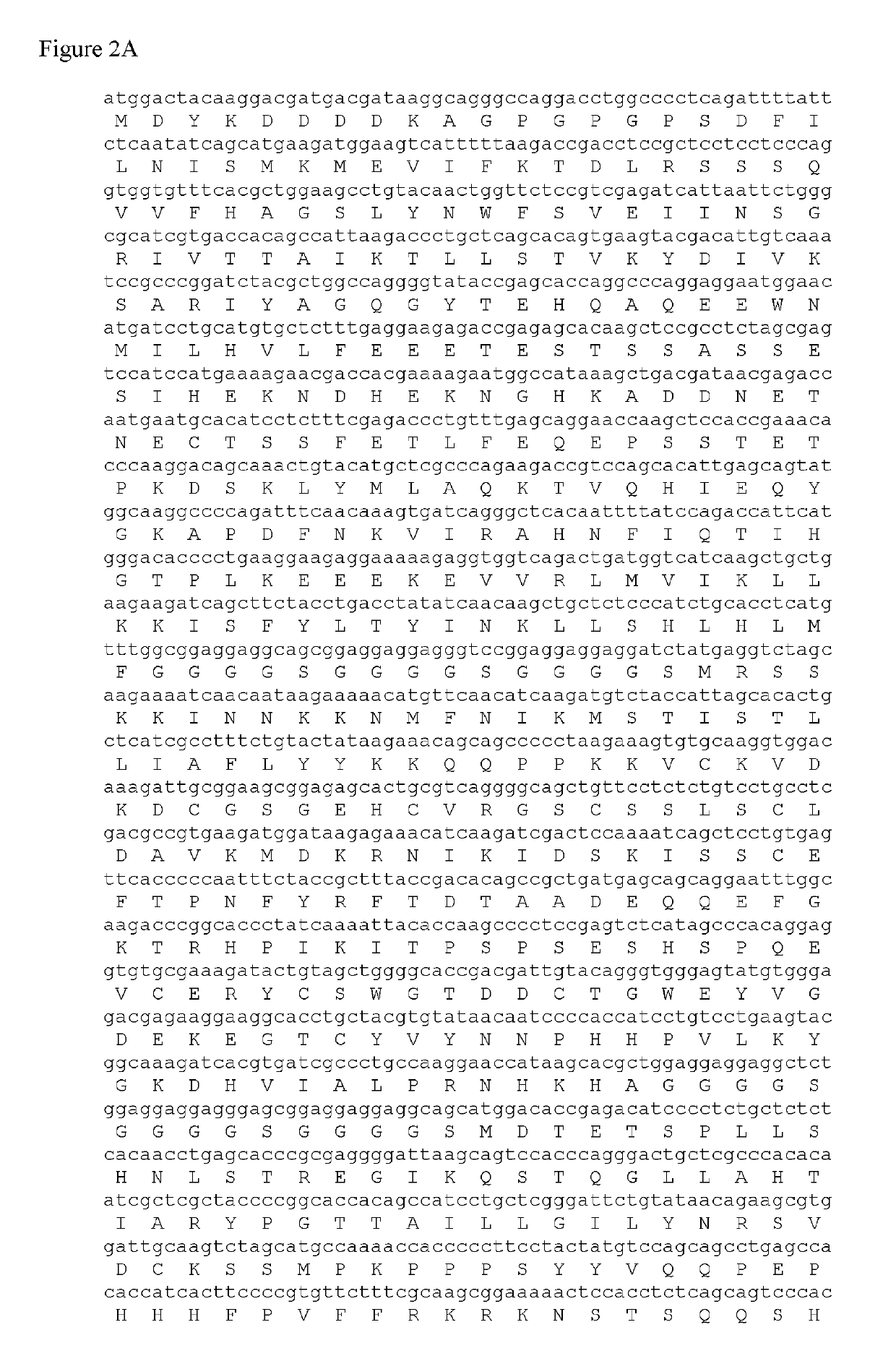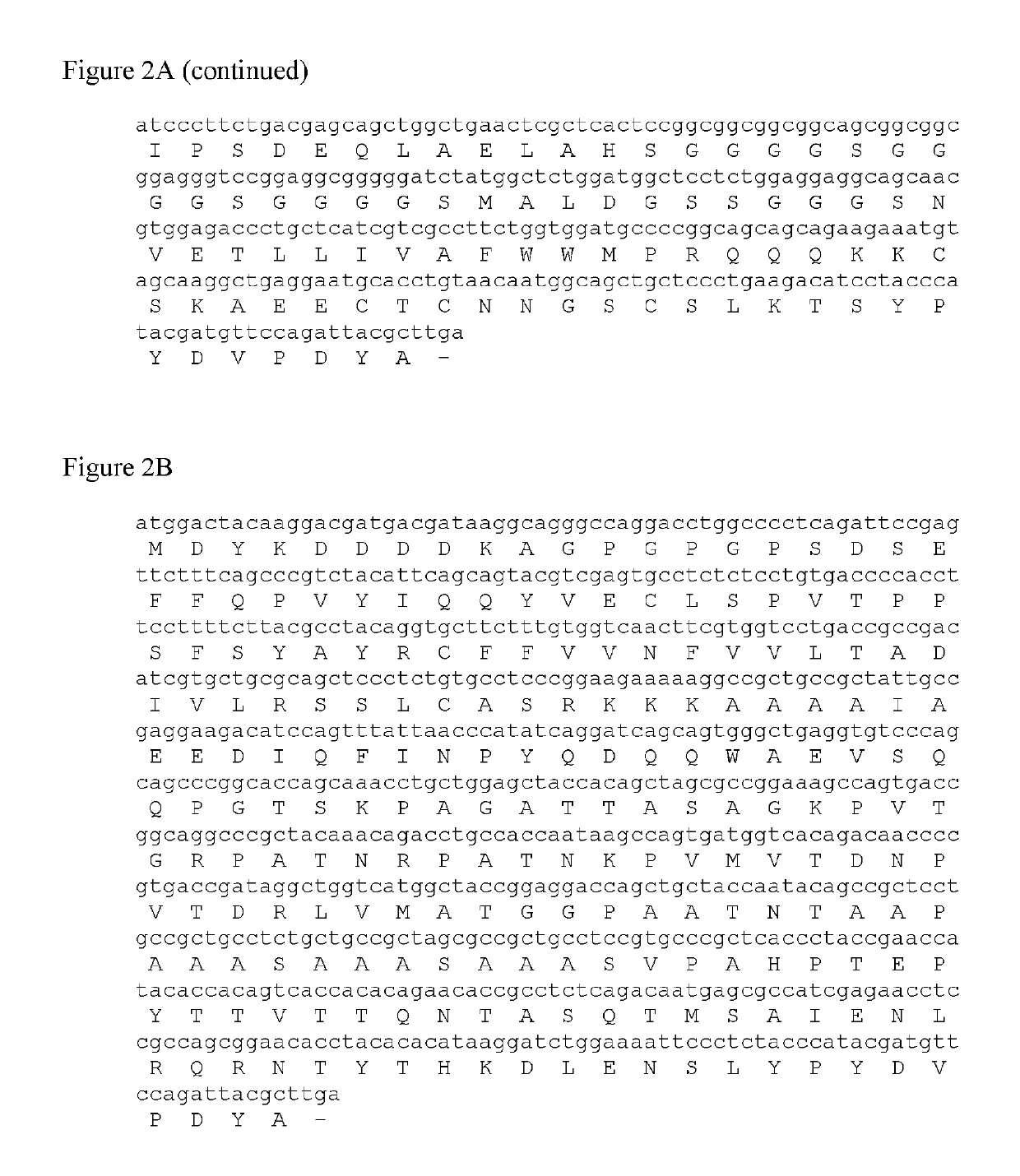Adenovirus-vectored multivalent vaccine
a technology of adenovirus and adenovirus, which is applied in the direction of viruses/bacteriophages, antibody medical ingredients, dsdna viruses, etc., can solve the problems of affecting the quality of life of patients, affecting the safety of patients,
- Summary
- Abstract
- Description
- Claims
- Application Information
AI Technical Summary
Benefits of technology
Problems solved by technology
Method used
Image
Examples
example 1
n of Constructs Encoding Lead Vaccine Candidate Antigens
[0106]Protein expression constructs (Baculovirus, mammalian, adenovirus, and Lentivirus) were generated encoding candidate synthetic genes (p32, p54, pp62, p′72, and pp220 polyprotein [it was split into p3′7; p150-I and p150-II due to its large size]) and modified to contain HA- and FLAG-tags fused in-frame at the 5′ and 3′ ends, respectively.
[0107]1. Generation of codon-optimized genes and design of expression cassette: The ASFV p32, p54, pp62 polyprotein (p62), p72, and pp220 (p37 [p37-p34-p14]; p150-I; and p150-II) amino acid sequences from all the currently sequenced genomes were aligned and using the George 2007 / 1 as the reference sequence, consensus amino acid sequences were identified and selected for this study. In most cases where there was no consensus sequence, Georgia 2007 / 1 amino acid sequences were selected. The amino acid sequence of each antigen was modified to add, in-frame, a FLAG- and HA-tag at the N- and C-t...
example 2
n of Protein Expression by Constructs
[0115]In order to evaluate protein expression by the constructs encoding target antigens and validate the expressed antigen:
[0116]i) Protein expression by the pCDNA3 constructs encoding the ASFV p32, p54, p72, p62, p37, p150-I, and p150-II antigens was evaluated by immunocytometric analysis of HEK 293A cell transfectants and ELISA analysis of supernatants using the anti-tag mAbs and validated authenticity of the antigens using ASFV-reactive superpig serum as described in Example 1.
[0117]ii) The pAd constructs generated above were transfected into HEK 293A cells and the clones expressing the encoded antigen were identified by immunocytometric analysis of the cell-transfectants probed with the anti-tag mAbs and the ASFV superpig serum as above. Data from the immunocytometric analysis was used to select six lead clones of each construct for virus assembly (FIG. 4). Miniprep DNA was generated for each construct and an aliquot of each was frozen as st...
example 3
n of Bulk Affinity Purified Recombinant Proteins
[0121]Bulk affinity purified recombinant proteins (p32, p54, p72, p62, p37; p150-I and p150-II) were generated and quality control tests using anti-tag mAbs and the ASFV-reactive superpig serum performed.
[0122]i) To generate recombinant proteins in mammalian cells, the pCDNA3 constructs encoding p32, p54, p72, p62, p37; p150-I and p150-II antigens had to be modified by adding an in-house optimized leader signal sequence, designated CD7, in-frame at the 5′ end of each gene for efficient protein secretion into the medium. Protein expression by miniprep DNA of the resultant constructs were screened by immunocytometric analysis and ELISA as above and the best performing clone of each construct was selected. Maxiprep DNA was prepared and quality control tested for protein expression. Pilot studies using HEK 293 Freestyle cell system (Invitrogen) showed that, only the pCDNA3CD7p62 construct gave sufficient protein yields and therefore, this ...
PUM
| Property | Measurement | Unit |
|---|---|---|
| Dynamic viscosity | aaaaa | aaaaa |
| Immunogenicity | aaaaa | aaaaa |
| Antigenicity | aaaaa | aaaaa |
Abstract
Description
Claims
Application Information
 Login to View More
Login to View More - R&D
- Intellectual Property
- Life Sciences
- Materials
- Tech Scout
- Unparalleled Data Quality
- Higher Quality Content
- 60% Fewer Hallucinations
Browse by: Latest US Patents, China's latest patents, Technical Efficacy Thesaurus, Application Domain, Technology Topic, Popular Technical Reports.
© 2025 PatSnap. All rights reserved.Legal|Privacy policy|Modern Slavery Act Transparency Statement|Sitemap|About US| Contact US: help@patsnap.com



